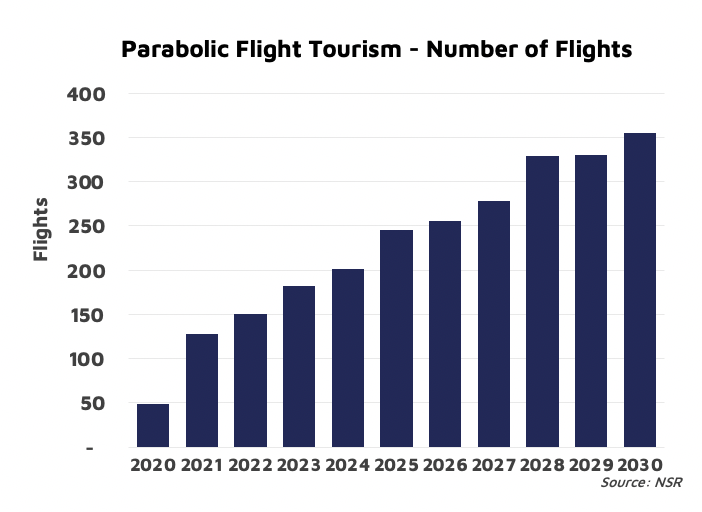Parabolic Flights: A Case Study for Space Travel & Tourism
The ongoing pandemic has presented a plethora of opportunities as well as challenges to some of the emerging business verticals like Space Tourism and Travel. Recently, the DearMoon project, initiated by Japanese billionaire Yusaku Maezawa recorded millions of participants applying to pursue their dream. On the other hand, Spaceport Cornwall rejected Virgin Galactic’s plan for expansion of their operations to conduct space tourism flights, and coupled with recent delays in launch, VG’s Chairman Chamath Palihapitiya dropped off his whole share from the company, valued at $213 Million.
Amidst all this negative news, the parabolic flight industry is still in operation, and one operator even received a much-needed boost: Zero-G Corporation announced a recent funding round to expand their operations to continue to serve celebrities, scientists and people looking for a thrilling ride.
NSR’s Space Tourism & Travel Markets, 2nd Edition report provides an in-depth analysis and forecast of the parabolic flight sector’s potential that shows it will grow revenues up to $170 million annually in 2030, flying almost 30,000 people by then. The revenue contribution is lower in comparison to orbital and suborbital markets; however, the market will attract thousands of customers annually, which is a significant amount to consider. The market is well established and unless further delays occur due to outside factors, it will increase its flight frequency up to 350 annually.
It is currently the only existing operational segment of the space tourism market, and CAPEX and R&D costs are significantly lower than suborbital and orbital flights. So, what is stopping parabolic flights from growing? Does it have the potential blend as a mainstream market, and is it a high-revenue generator in the future? Can it be used as an example or a steppingstone to assist the struggling space tourism market for the future?

A Marketing Case Study
The parabolic flight industry is a small revenue generator compared to the other segments, yet it is the most active contributor in terms of passengers in the overall space travel and tourism market. Zero-G experiences at prices below $7,000 are far more affordable compared to suborbital flights at roughly $250,000, which are still in the development stages. With the current pandemic, flights were delayed but are now back in operation, but with fewer participants under tighter safety precautions. Despite these concrete advantages, the market appears to be under the radar, and the following shortcomings might make a difference and help raise the profile that it deserves.
- Onboard Experience: Even with affordable zero gravity flights, consumers prefer comfort combined with a unique experience rather than just a simple ‘one-off’ short-lived experience. A majority will prefer spending a month-long European tour with family rather than experiencing 10-15 mins of microgravity for the same price. Thus, reaching a broader population with a better onboarding experience and exciting family offers may improve its potential.
- Marketing: Zero-gravity flight operators have carried out limited marketing campaigns, which is impacting sales. A wider audience with attractive offers, tailored to specific market targets is essential in the space tourism industry. In comparison to the parabolic flight market, sub-orbital and orbital perform better at marketing with a logjam of demand without any supply today.
- Networking: There are currently no common platforms to network or communicate with people who shares a similar passion for parabolic flight. The customers can act as a driver to amplify the unique experience and foster more social media interactions about the ” Zero-G experience”, thus enhancing its excitement.
Bottom Line
Despite having a unique and ‘out-of-this-world’ value proposition, with numerous offers and reliable frequent operation, there are several challenges to growth that parabolic flight needs to address, such as the ‘family onboard experience’ and better marketing. And with a heavier demand that is not showing any signs of slowing down, suborbital and orbital tourism can look to the parabolic flight market’ case and study how it can start building the much-needed ecosystem and market drivers to help sustain space travel and tourism through the coming decade.
# # #
NSR supports satellite and launcher manufacturers, space tourism operators, satellite services providers and operators, end-users, space agencies, government and financial institutions in their technology and business strategy assessment and planning.
Please contact info@nsr.com for more information.
